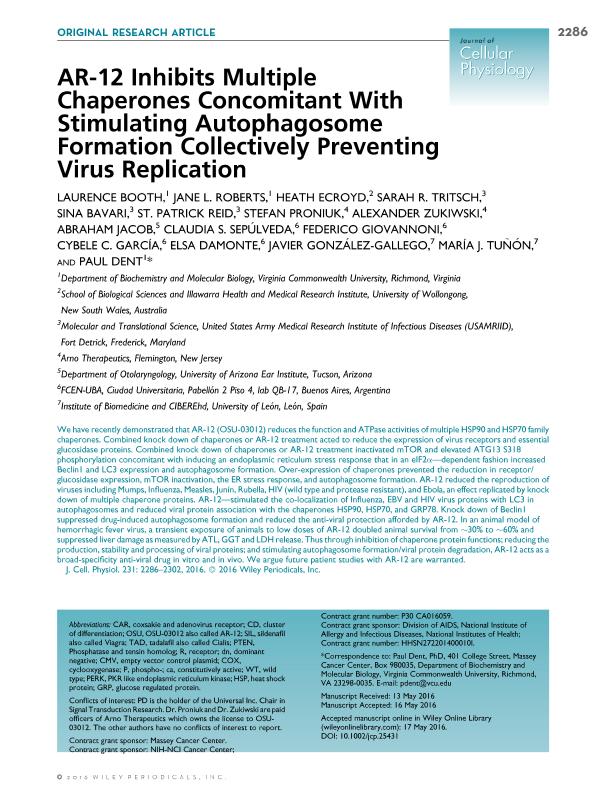Mostrar el registro sencillo del ítem
dc.contributor.author
Booth, Laurence
dc.contributor.author
Roberts, Jane L.
dc.contributor.author
Ecroyd, Heath
dc.contributor.author
Tritsch, Sarah R.
dc.contributor.author
Bavari, Sina
dc.contributor.author
Reid, St. Patrick
dc.contributor.author
Proniuk, Stefan
dc.contributor.author
Zukiwski, Alexander
dc.contributor.author
Jacob, Abraham
dc.contributor.author
Sepúlveda, Claudia Soledad

dc.contributor.author
Giovannoni, Federico

dc.contributor.author
Garcia, Cybele

dc.contributor.author
Damonte, Elsa Beatriz

dc.contributor.author
González Gallego, Javier
dc.contributor.author
Tuñón, María J.
dc.contributor.author
Dent, Paul
dc.date.available
2018-08-16T15:30:13Z
dc.date.issued
2016-10
dc.identifier.citation
Booth, Laurence; Roberts, Jane L.; Ecroyd, Heath; Tritsch, Sarah R.; Bavari, Sina; et al.; AR-12 Inhibits Multiple Chaperones Concomitant With Stimulating Autophagosome Formation Collectively Preventing Virus Replication; Wiley-liss, Div John Wiley & Sons Inc; Journal of Cellular Physiology; 231; 10; 10-2016; 2286-2302
dc.identifier.issn
0021-9541
dc.identifier.uri
http://hdl.handle.net/11336/55895
dc.description.abstract
We have recently demonstrated that AR-12 (OSU-03012) reduces the function and ATPase activities of multiple HSP90 and HSP70 family chaperones. Combined knock down of chaperones or AR-12 treatment acted to reduce the expression of virus receptors and essential glucosidase proteins. Combined knock down of chaperones or AR-12 treatment inactivated mTOR and elevated ATG13 S318 phosphorylation concomitant with inducing an endoplasmic reticulum stress response that in an eIF2α—dependent fashion increased Beclin1 and LC3 expression and autophagosome formation. Over-expression of chaperones prevented the reduction in receptor/glucosidase expression, mTOR inactivation, the ER stress response, and autophagosome formation. AR-12 reduced the reproduction of viruses including Mumps, Influenza, Measles, Junín, Rubella, HIV (wild type and protease resistant), and Ebola, an effect replicated by knock down of multiple chaperone proteins. AR-12—stimulated the co-localization of Influenza, EBV and HIV virus proteins with LC3 in autophagosomes and reduced viral protein association with the chaperones HSP90, HSP70, and GRP78. Knock down of Beclin1 suppressed drug-induced autophagosome formation and reduced the anti-viral protection afforded by AR-12. In an animal model of hemorrhagic fever virus, a transient exposure of animals to low doses of AR-12 doubled animal survival from ∼30% to ∼60% and suppressed liver damage as measured by ATL, GGT and LDH release. Thus through inhibition of chaperone protein functions; reducing the production, stability and processing of viral proteins; and stimulating autophagosome formation/viral protein degradation, AR-12 acts as a broad-specificity anti-viral drug in vitro and in vivo. We argue future patient studies with AR-12 are warranted. J. Cell. Physiol. 231: 2286–2302, 2016. © 2016 Wiley Periodicals, Inc.
dc.format
application/pdf
dc.language.iso
eng
dc.publisher
Wiley-liss, Div John Wiley & Sons Inc

dc.rights
info:eu-repo/semantics/openAccess
dc.rights.uri
https://creativecommons.org/licenses/by-nc-sa/2.5/ar/
dc.subject
Chaperones
dc.subject
Antiviral
dc.subject
Ar-12
dc.subject
Autophagosomes
dc.subject.classification
Otras Ciencias Biológicas

dc.subject.classification
Ciencias Biológicas

dc.subject.classification
CIENCIAS NATURALES Y EXACTAS

dc.title
AR-12 Inhibits Multiple Chaperones Concomitant With Stimulating Autophagosome Formation Collectively Preventing Virus Replication
dc.type
info:eu-repo/semantics/article
dc.type
info:ar-repo/semantics/artículo
dc.type
info:eu-repo/semantics/publishedVersion
dc.date.updated
2018-08-13T18:32:20Z
dc.journal.volume
231
dc.journal.number
10
dc.journal.pagination
2286-2302
dc.journal.pais
Estados Unidos

dc.journal.ciudad
Nueva York
dc.description.fil
Fil: Booth, Laurence. Virginia Commonwealth University; Estados Unidos
dc.description.fil
Fil: Roberts, Jane L.. Virginia Commonwealth University; Estados Unidos
dc.description.fil
Fil: Ecroyd, Heath. University of Wollongong; Australia
dc.description.fil
Fil: Tritsch, Sarah R.. United States Army Medical Research Institute of Infectious Diseases; Estados Unidos
dc.description.fil
Fil: Bavari, Sina. United States Army Medical Research Institute of Infectious Diseases; Estados Unidos
dc.description.fil
Fil: Reid, St. Patrick. United States Army Medical Research Institute of Infectious Diseases; Estados Unidos
dc.description.fil
Fil: Proniuk, Stefan. Arno Therapeutics; Estados Unidos
dc.description.fil
Fil: Zukiwski, Alexander. Arno Therapeutics; Estados Unidos
dc.description.fil
Fil: Jacob, Abraham. University of Arizona; Estados Unidos
dc.description.fil
Fil: Sepúlveda, Claudia Soledad. Consejo Nacional de Investigaciones Científicas y Técnicas; Argentina. Universidad de Buenos Aires. Facultad de Ciencias Exactas y Naturales; Argentina
dc.description.fil
Fil: Giovannoni, Federico. Consejo Nacional de Investigaciones Científicas y Técnicas; Argentina. Universidad de Buenos Aires. Facultad de Ciencias Exactas y Naturales; Argentina
dc.description.fil
Fil: Garcia, Cybele. Consejo Nacional de Investigaciones Científicas y Técnicas; Argentina. Universidad de Buenos Aires. Facultad de Ciencias Exactas y Naturales; Argentina
dc.description.fil
Fil: Damonte, Elsa Beatriz. Consejo Nacional de Investigaciones Científicas y Técnicas; Argentina. Universidad de Buenos Aires. Facultad de Ciencias Exactas y Naturales; Argentina
dc.description.fil
Fil: González Gallego, Javier. Universidad de León; España
dc.description.fil
Fil: Tuñón, María J.. Universidad de León; España
dc.description.fil
Fil: Dent, Paul. Virginia Commonwealth University; Estados Unidos
dc.journal.title
Journal of Cellular Physiology

dc.relation.alternativeid
info:eu-repo/semantics/altIdentifier/doi/https://dx.doi.org/10.1002/jcp.25431
dc.relation.alternativeid
info:eu-repo/semantics/altIdentifier/url/https://onlinelibrary.wiley.com/doi/abs/10.1002/jcp.25431
Archivos asociados
